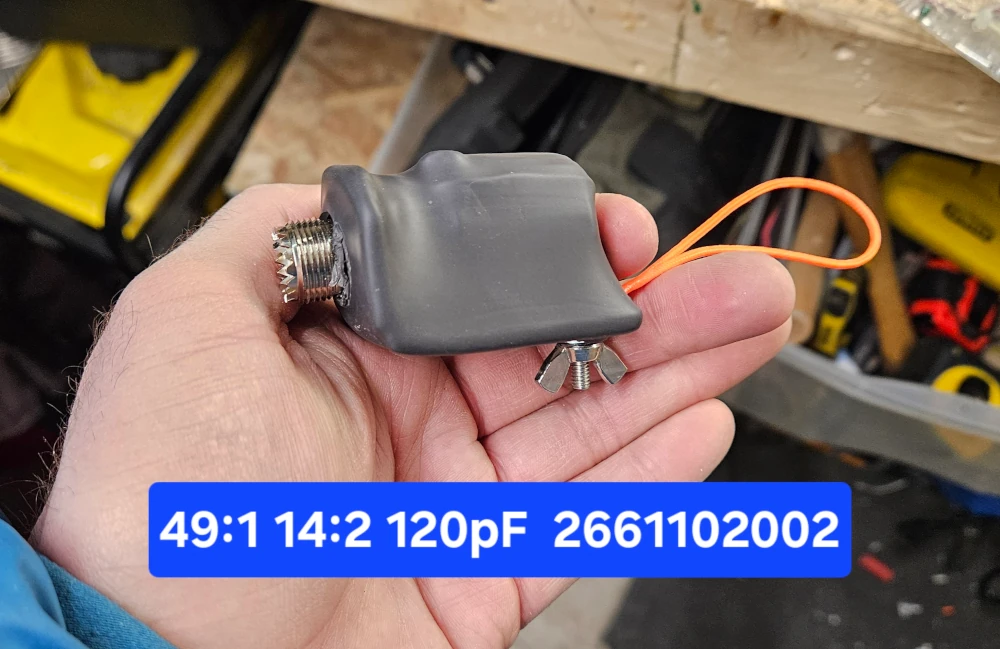EFHW for QRO
I still really like QRP operating. But you know, sometimes there’s zero substitute for raw power. And by raw power I mean like 20w. LOL. Or maybe 50w or even 100w. Perhaps, though, you still want a pocket-portable EFHW transformer that is ultra efficient?
Concept
My previous EFHW for QRP was pretty good. Super lightweight and compact. But it was a bit lacking in the efficiency department. The stacked double core did help it but there is another core that is still pretty darn compact and extremely efficient. Every little bit of efficiency helps, especially when operating QRP. In fact, I would recommend the following design as a QRP build. Just have to swap the connector for a BNC if you wanted to use lighter weight coax.
Build Notes
Core
It’s an exciting time for Ham Radio because there are lots and lots of nifty ferrite cores with different geometry and mixes to try. We’ve moved far beyond the standard Type 43 2.4” toroids of yore. In fact, this Type 61 core shows a great deal of promise. First the overall shape. It’s really compact! 1.020” (25.91mm) OD. Core: 2661102002 and it was only $8.33 in 2025. The photo shows this core next to the Type 43 “fatty.”
It’s quite a difference! But it has incredible efficiency. There was quite a bit of testing done on this core by Evil Lair Electronics - check out his most recent videos. It really is a top performer with minimal losses. I’ve built this core as a 64:1 and the one shown here as a 49:1 (2 primary & 14 secondary).
Sled
I built this build on the same dollar store cutting board that I did for the QRP version. The “sled” was measured to length, heated with a heat gun then bent in a vice. This build uses the bigger SO-239 connector because I’m going to use larger coax. But you could easily use a BNC instead.
Capacitor
I used a 120pF capacitor (CC45SL3FD121JYNNA) on the advice of Evil Lair. It just fits in this compact build. Hot glue to keep everything in order.
Heat Shrink
95 Paracord loop as a hanger, and I put some good shrink wrap around the whole thing to make it perdy. I did have to use a bit of paint on electrical tape to help seal up the shrink wrap and make it water tight.
Deployment
This build design doesn’t have a spot for a dedicated counterpoise. So using a 1:1 choke in the preferred/optimal method isn’t in the cards (though you could use an unchoked piece of coax as counterpoise and put a 1:1 just after that towards the rig). However, the more I thought about this build, the more I thought I would change up the deployment. Normally I keep the transformers low/on the ground and shoot the wire up. But what if we instead took this transformer up and brought the wire out?
This way, if the unchoked coax is going to radiate, at least it is up off the ground. My hunch was this setup might perform like an inverted L radiation pattern, perhaps with a smidgen of gain?
Field Tests
Setup
I setup the antenna much like my concept diagram above, but I used the tree to support the transformer. I raised it up to around 28’ high with a rope over a tree branch. 50’ of unchoked coax was suspended straight down and then across the ground to the gazebo where the radio and computer were setup. I did have a 1:1 choke at the rig end of the coax. I used a resonant half wave wire cut for the 20M band for this test (22AWG BNTECHGO silicone wire). I tied the other end of the wire to my DX Commander expedition mast and leaned it up in a tree. The wire was not super taught and had a bit of a sag to it. SWR was good, around 1.4:1 at its worst. I didn’t additionally tune the wire.
The light weight core of the transformer made this deployment super easy.
WSPR Results
Here’s the 1 watt, 24 minute WSPR results. They are very exciting! The wire was deployed North/South and provided some sweet DX with 5 Austria, 5 Belgium, 1 Denmark, 6 France, 3 Germany, 5 Greece, 1 Netherlands and 2 UK contacts!
Regarding my “inverted L pattern” hypothesis, I think my hunch was incorrect. The WSPR pattern doesn’t show any real directional gain that would make sense as to how it was deployed. If anything, it resembles a vertical antenna with stellar omni-directional performance! Perhaps though, the coax and antenna shape might be functioning more like a 20M half-square. Granted, it has one side laying on the ground which isn’t optimal. But no matter how you slice it, it’s really getting out there with this deployment setup.
Wrap Up
All in all this core is awesome. It’s a huge contender for QRP builds as well as QRO. Also, it has a really high temperature rating which will translate into being stellar for full duty cycle digital modes. It’s definitely worth adding to your short list of excellently efficient cores for a build that is pocket portable.
73 de VE5REV










